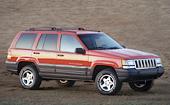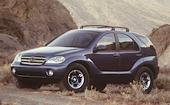

| There are currently 31 sport utility model lines for sale on the U.S. market-- all pictured and described in CarPoint. |

|
|
The Toyota 4Runner has been redesigned for 1996, offering a host of improvements. With a longer wheelbase, new suspension and reduced engine vibration, the new 4Runner provides a more comfortable, stable ride.
|
Traditionally built on heavy-duty truck platforms, sport-utility vehicles combine the hard-working utility of an off-road vehicle with all the creature comforts of the family car--right down to the cupholders. Many passenger car and minivan owners are drawn by a sense of security that comes from the increased visibility offered by a sport utility's high seating position. Others are attracted by the vehicle's solid construction, all-weather capability and no-nonsense image.
Return to top

|
|
With a heritage stemming from the 1940s, the Grand Cherokee represents Jeep's latest step in the evolution of the sport-utility vehicle. With dual airbags, AWD technology and available luxury interior, this Jeep excels at taking its passengers through adverse conditions in comfort.
|
The concept of a go-anywhere, haul-anything vehicle began during the 1940s when the Willys-Overland company won a bid from the U.S. Army to build light reconnaissance vehicles for use during World War II. After the war, these Jeeps, as they came to be called, slowly evolved into civilian-use vehicles.
The first Jeep vehicle designed exclusively for family transportation arrived in 1962 when Kaiser Jeep introduced the Grand Wagoneer. It had the size and comfort of a passenger car along with four-wheel drive and an automatic transmission.
The category took a significant step forward in 1984 with the introduction of the Jeep Cherokee and heated up even more as Japanese automakers Toyota and Nissan entered the market in 1984 and 1987, respectively, with enclosed versions of their popular compact pickup trucks. Today, Toyota's 4-Runner and Nissan's Pathfinder represent two of the most refined compact sport utilities on the market.
Advances in drivetrain, engine, and safety technologies are key to the evolution of the category. Most sport utilities now offer an advanced V6 or V8 engine coupled to an on-demand or full-time four-wheel-drive configuration. And many offer anti-lock brakes and dual airbags. The result is a secure, smooth and quiet motoring experience in a wide range of conditions.
Return to top

|
|
Toyota has entered the new mini sport-utility market with the RAV4. With 120 horsepower and a ground clearance of over seven inches, the RAV4 does a fine job of keeping up with its larger cousins.
|
Following on the popularity of the entry-level Suzuki Sidekick and Kia Sportage, Toyota, Honda, Mitsubishi and Suzuki have all entered the mini sport-utility segment with new compact, lower-cost vehicles in the past year. While the Mitsubishi Pajero Mini isn't yet slated for U.S. availability, recent U.S. introductions of the Toyota RAV4, Suzuki X-90, and the forthcoming Honda CR-V have helped to expand this new segment, bringing in new sport-utility customers.
Return to top

|
|
Earlier this year, Mercedes unveiled this unique concept vehicle that combines the attributes of a sport-utility with the safety and comfort of a Mercedes passenger car. The M-Class All-Activity Vehicle (AAV)--the production vehicle based on this concept--is scheduled to go on sale in the fall of 1997, priced in the mid-$30,000 range.
|
Priced between $35,000 and $47,500, the Mercedes M-Class All-Activity Vehicle (AAV), Acura SLX, and Lexus LX450 bring luxury car comfort and refinement to the popular sport-utility market. These luxury SUVs cater to the needs of a very discerning audience, one that places a premium on comfort and convenience, while still appreciating solid off-road capability. Another newcomer is the 1997 Mountaineer--Mercury's upscale answer to the best-selling Ford Explorer.
Return to top

|
|
The AM General Hummer is easily considered the ultimate 4X4. With a ground clearance of 16 inches, the Hummer driver even has the option of inflating or deflating the tires to match terrain conditions without ever leaving the vehicle.
|
Return to top